Tag archives: Stephen Hawking
Happy Hedgehog Day, play like Einstein, Hawking could be in court over NHS
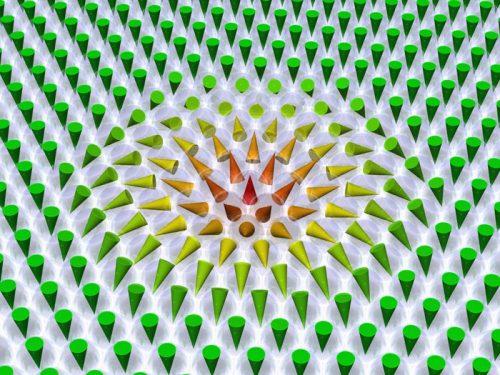
Magnetic hedgehog: illustration of a skyrmion (Courtesy: Wiesendanger Group, University of Hamburg)
By Michael Banks and Hamish Johnston
Today, people are celebrating Hedgehog Day – possibly as an alternative to Groundhog Day, which is a tradition in North America. There is a nice connection between the spiny critters and physics because diagrams illustrating magnetic quasiparticles called skyrmions are sometimes referred to as hedgehogs. This is because the magnetization associated with a skyrmion can resemble the spines of the hedgehog. The above image is from a news story about skyrmion research done by Kirsten von Bergmann, André Kubetzka and Roland Wiesendanger at the University of Hamburg.
View all posts by this author | View this author's profile
Hawking’s PhD thesis, Einstein letter up for auction, first zero
By Michael Banks
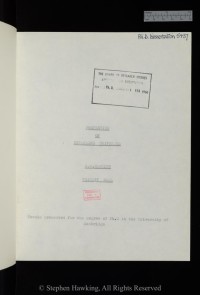
Courtesy: University of Cambridge
The PhD thesis of the University of Cambridge physicist Stephen Hawking was made freely available to read this week by the university’s Library’s Office of Scholarly Communication.
Hawking completed his PhD – entitled “Properties of expanding universes” – in 1966 when he was 24 years old. To mark Open Access Week 2017, the 117-page tome was posted on the university’s Apollo open-access repository, which is already home to some 15,000 research articles and 2400 theses.
Yet within hours of Hawking’s opus being posted online, demand was so great that the site crashed. However, according to the university, it was still downloaded more than 60,000 times in the first 24 hours.
“By making my PhD thesis open access, I hope to inspire people around the world to look up at the stars and not down at their feet,” Hawking noted. “Anyone, anywhere in the world should have free, unhindered access to not just my research, but to research of every great and enquiring mind across the spectrum of human understanding.”
View all posts by this author | View this author's profile
Great wagers in physics, CERN’s pine marten gets stuffed, Doomsday Clock moves closer to midnight
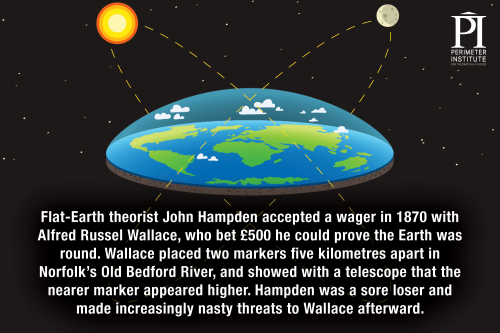
Flat out: Wallace saw him coming. (Courtesy: PI)
By Hamish Johnston
I bet you can’t resist clicking on “Great wagers in physics history” – which has been compiled by Colin Hunter at the Perimeter Institute for Theoretical Physics in Canada. A surprising number involve Stephen Hawking, whose record on winning is quite abysmal according to Hunter. Hawking’s fellow Cantabrigian Isaac Newton also enjoyed a flutter and accepted Christopher Wren’s offer of 40 shillings to anyone who could – in two months – derive a force law that explained Keplers laws of planetary motion. Newton succeeded, but ran overtime so he didn’t collect the cash. In the image above you can read about another wager involving a “flat-Earth theorist”.
View all posts by this author | View this author's profile
Stephen Hawking turns 75 with commemorative tome
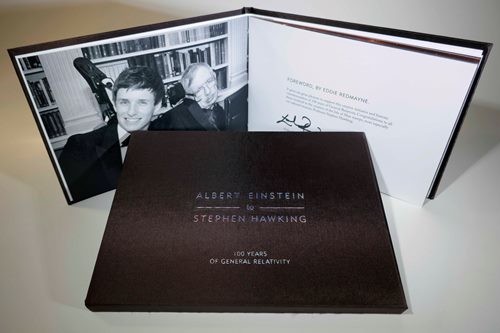
Special edition. (Courtesy: Isle of Man Post Office and Glazier Design)
By Michael Banks
What better way to celebrate Stephen Hawking’s 75th birthday than a limited edition commemorative book?
To mark the occasion, the Isle of Man Post Office has released Albert Einstein to Stephen Hawking: 100 Years of General Relativity – a 32-page glossy tome that features quotes from the two famous physicists.
View all posts by this author | View this author's profile
Inspiring young physicists, telescope buyer’s guide, time-travelling pyramid builders
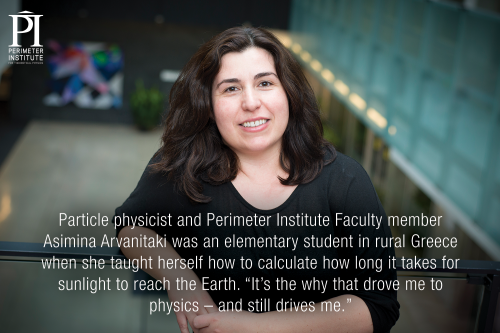
Sunlight calculator: Asimina Arvanitaki. (Courtesy: PI)
By Hamish Johnston
Have you ever wondered what inspires talented physicists to pursue careers in physics? To try to answer that question, the Perimeter Institute for Theoretical Physics (PI) in Canada has produced a set of tiles that explain how some famous physicists – and some up-and-coming stars – became hooked on physics at a young age. An early love of back-of-the-envelope calculations seems to have set the stage for the PI’s Asimina Arvanitaki as she explains in the above tile. Can you guess which Nobel laureate used to stare at a clock pendulum for hours to try to figure out how it worked? The answer to that teaser and much more can be found in “How great scientists get hooked on science”.
View all posts by this author | View this author's profile
Riding a laser beam to Alpha Centauri, how the Sun pushes on the Earth and 22 kinds of space tape
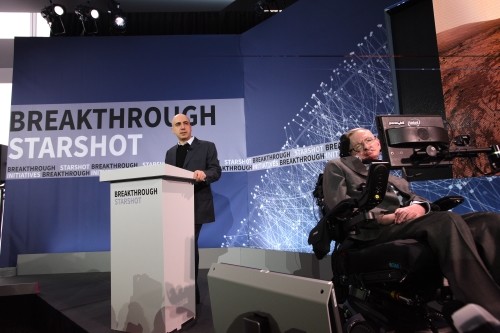
Stars in their eyes: Yuri Milner (left) and Stephen Hawking. (Courtesy: Bryan Bedder)
By Hamish Johnston
What to do if you have millions of dollars lying around and a keen interest in physics? The physicist turned Internet tycoon Yuri Milner has already spent some of his fortune rewarding leading scientists and funding research. His latest project is called “Starshot” and involves spending a cool $100m on sending a spaceship to Alpha Centuri – the closest star system to Earth at just 40 trillion kilometres away.
View all posts by this author | View this author's profile
Waves of soup, spying on gravity and touring the solar system

Nathan Myhrvold’s gravity-inspired soup bowl. (Courtesy: Modernist Cuisine)
By Hamish Johnston
Nathan Myhrvold knows a lot about gravity (he worked with Stephen Hawking) and a lot about food (he wrote Modernist Cuisine) so it’s not really surprising that he has designed a soup bowl inspired by the collision of two black holes. Created in 2014, the bowl was made to hold two different types of soup in swirls of space–time. Now that the LIGO observatory has spotted a gravitational wave from the collision of two such black holes, I’m guessing sales of the bowl will be out of this world.
View all posts by this author | View this author's profile
Soft hair on black holes, making concrete on Mars and exploring the cosmos in 2016
By Hamish Johnston
This week’s Red Folder looks to the cosmos, starting with a spiffy new video from the European Space Agency. The slick presentation is a preview of some of the extra-terrestrial exploits that the agency has planned for 2016. This includes the landing of the Schiaparelli probe on the surface of Mars. This stationery lander will survey its Martian environs to find a suitable location to drop the ExoMars rover in 2018. The mission’s namesake is the Italian astronomer Giovanni Schiaparelli, who mapped the surface of Mars and was the first to use the term canali to describe the straight lines that were thought to exist on the surface of the planet.
It’s possible that someday humans will colonize Mars and this will involve building dwellings and other structures on the Red Planet. In preparation, Lin Wan, Roman Wendner and Gianluca Cusatis at Northwestern University in the US have come up with a recipe for making concrete on Mars. The trio reckon that any successful colonization of the Red Planet will have to rely on local building materials because shipping stuff from Earth would be horrendously expensive.
Hawking on 1D, Chernobyl fires, psychedelic science and more
By Tushna Commissariat
It’s not often that physics, or indeed a physicist, has much in common with pop music or exceedingly popular boy bands. But earlier this week, at an event at the Sydney Opera House titled “An Evening with Stephen Hawking, with Lucy Hawking and Paul Davies”, an audience member asked Hawking (who appeared in holographic form) “What do you think is the cosmological effect of Zayn Malik leaving One Direction?” Watch the video above to see what Hawking said to comfort the distraught fan and how theoretical physics truly may have all the answers.
Villainous physicists, Hubble’s cat and more

Eddie Redmayne as Stephen Hawking in the film The Theory of Everything. (Courtesy: Universal Pictures International)
By Tushna Commissariat
This week we heard about a possible new James Bond film villain and its none other than Stephen Hawking. According to this story in the Telegraph, he feels as if his trademark wheelchair and computerized voice would lend themselves perfectly to the part. On the same note, we saw this interesting feature on the Wired website that looks at the history behind Hawking’s very recognisable voice. Last month, I was lucky enough to attend an early screening of James Marsh’s Hawking biopic The Theory of Everything, which includes a rather touching and funny scene of Hawking testing out his voice for the first time. You can read more about the film in the reviews section of the upcoming January issue of Physics World.
View all posts by this author | View this author's profile